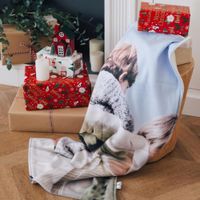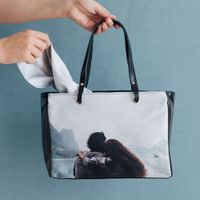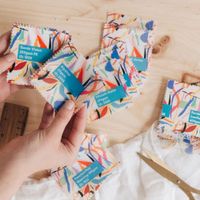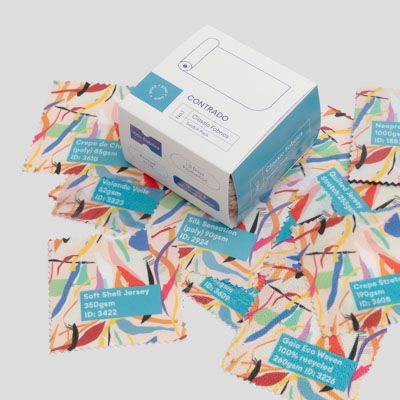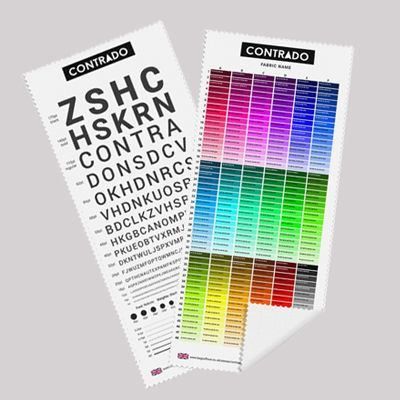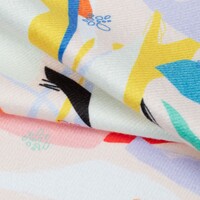Range of Custom Polycotton Fabric
Choose from a wide range of polycotton fabrics for your dressmaking or craft projects.
-
![Woven Canvas]()
Woven Canvas
-
Max Print:
1.57m
-
Weight:
300gsm
-
Roll Width:
1.59m
Thick canvas with a tight weave. Subtle smooth face, ideal for wall art, upholstery.
Composition:100% polyester
-
![Peached Poly Sheeting]()
Peached Poly Sheeting
-
Max Print:
1.79m
-
Weight:
130gsm
-
Roll Width:
1.85m
Soft Peached surface, Matte, Slightly Transparent, Woven, Blend. Light but strong touch. Use: bedding, pillows, sheets.
Composition:100% polyester
-
![Panama Flo]()
Panama Flo
-
Max Print:
1.47m
-
Weight:
150gsm
-
Roll Width:
1.49m
Soft, Matte, Opaque, Woven, Poly. Half Panama and durable weave. Use: table cloths, shopping bags.
Composition:100% polyester
-
![Mayfair Herringbone Weave]()
Mayfair Herringbone Weave
-
Max Print:
1.43m
-
Weight:
269gsm
-
Roll Width:
1.45m
Soft, Matte, Woven, Herringbone weave. Cotton feel. Medium weight. Some transparency. Use: soft furnishing, craft projects.
Composition:100% polyester
-
![Lima Cotton Twill]()
Lima Cotton Twill
-
Max Print:
1.47m
-
Weight:
240gsm
-
Roll Width:
1.49m
Real Cotton Twill with dye sub layer. 84% cotton / 16% poly by weight. Cotton back, poly face for best print
Composition:84% cotton / 16% poly
-
![Trafalgar Twill]()
Trafalgar Twill
-
Max Print:
1.5m
-
Weight:
274gsm
-
Roll Width:
1.52m
Soft, Matte, Opaque, Woven. Cotton twill look. Use: coats, artist canvas, soft furnishing, craft projects.
Composition:100% polyester
-
![Poly Twill]()
Poly Twill
-
Max Print:
1.44m
-
Weight:
200gsm
-
Roll Width:
1.46m
Classic 2/2 Twill weave in a poly blend. Strong and durable fabric. Upholstery, cushions and more.
Composition:100% polyester
-
![Mulmul Soft Muslin (poly)]()
Mulmul Soft Muslin (poly)
-
Max Print:
1.29m
-
Weight:
55gsm
-
Roll Width:
1.31m
Soft, smooth and strong poly muslin fabric. A classic voile like weave, open net. Dresses, scarves, blouses, shirts, craft.
Composition:100% polyester
-
![Woven Canvas]()
Woven Canvas
-
Max Print:
1.5m
-
Weight:
500gsm
-
Roll Width:
1.52m
Stiff, Matt, Opaque, Woven, Poly. Heavier Weight Canvas. Use: bags, sails, heavy canvas, upholstery, wall art.
Composition:100% polyester
-
![Sailor's Woven Canvas]()
Sailor's Woven Canvas
-
Max Print:
1.42m
-
Weight:
480gsm
-
Roll Width:
1.44m
Heavy weight, rustic plain weave canvas. Hard wearing, Sailor's canvas. Uses: soft furnishings, bags, cushions, home textiles. Softens with washing. Edges will fray. Chunky weave, so fine detail not recommended.
Composition:100% Polyester
-
![Tender Terry Towelling]()
Tender Terry Towelling
-
Max Print:
1.5m
-
Weight:
350gsm
-
Roll Width:
1.52m
Soft, Matt, Opaque, Woven 55% Poly, 45% Cotton towelling. Absorbent microfibre with Terry cotton back. Uses: Towels, washcloths, dressing gowns, bibs
Composition:55% polyester, 45% cotton
Care instructions
Wash at 30°C, low tumble dry heat, hang to dry, do not wring, low heat iron.
Edge Finishing
Depending on how you plan to use your custom material, you can choose how you want the edges to be finished:
- As it comes. We roughly cut around your image, leaving a simple scissor cut (perhaps uneven white fabric border).
- Hem with thread. We can hem your fabric with a choice of black or white thread. Please allow 1-2 days additional production time. See below for information on how hemming affects the size of your print.
- Cut on the line. We neatly and precisely cut on the edge of your image.
If you choose to have your textile finished with a hem, please bear in mind these measurements and ensure you factor this into your dimensions.
- Light fabrics: we use 6-8mm in the hem (2 fold), so your width/height will be minus 12-16mm
- Medium fabrics that fray: we use 15-20mm in the hem (2 fold) so your width/height will be minus 35-40mm
- Stiff/heavy/no-fray fabrics: we use 15-20mm in the hem (1 fold) so width/height will be minus 35-40mm
How to Care for Polycotton
Thanks to the polyester fibres, caring for your fabric should be straight forward. On the whole we recommend machine washing at 30°c, however please refer to your specific fabric's care instructions.
Due to the delicate nature of the Mulmul Soft Muslin fabric, some pulls are to be expected and this is not out of the ordinary.
What Can I Make With My Polycotton Fabric?
The opportunities are almost endless. Use the peached poly sheeting to make bespoke bedding such as pillowcases, sheets and duvet covers. The soft, smooth face feels lovely against the skin. The Trafalgar twill is perfectly suited to making jackets or coats, whilst the mulmul muslin with its open weave is better for lightweight scarves, dresses and blouses. Polycotton fabrics are so varied and different in nature, but all produce wonderful, vibrant prints to show off your photos and patterns perfectly.
